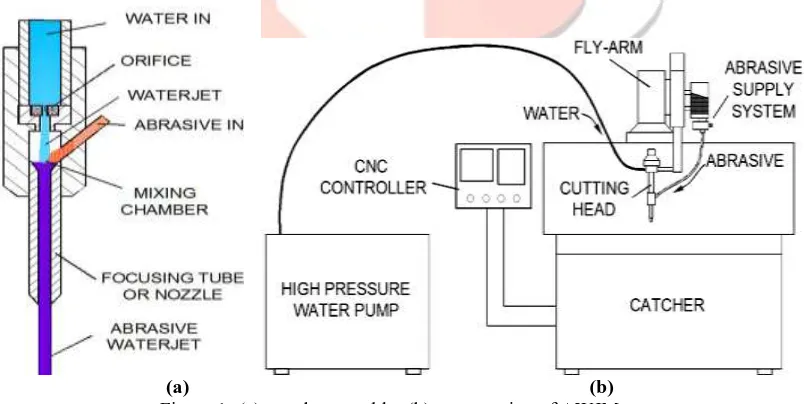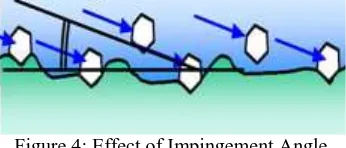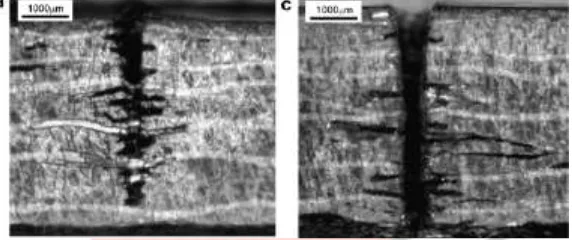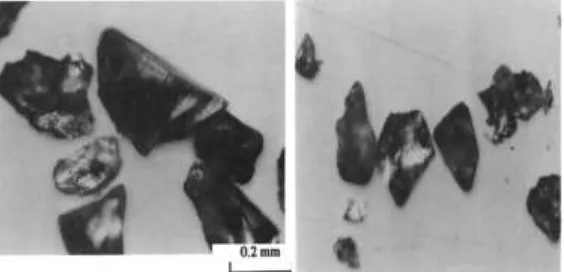IJEDR1602152
International Journal of Engineering Development and Research (www.ijedr.org)860
A Review on Abrasive Water Jet Machining On
Different Material
1 Rushabh B. Joshi, 2Dr. A. A. Shaikh, 3Brijesh K. Gotawala 1PG Student, 2Associate Professor, 3Assistant Professor
1Mechanical Department,
1Shri S’ad Vidhya Mandal Institute of Technology, Bharuch, India
________________________________________________________________________________________________________
Abstract - Manufacturing processes mainly deals with material removal to shape a component from bulk material. Conventional machining processes have drawbacks such as low cutting rates, high tool wear and poor surface quality. Due to these drawbacks non-conventional machining introduced with higher cutting rates and better surface quality. Abrasive water jet machining (AWJM) is non-conventional machining process which capable to machine wide range of hard-to-cut materials. Absence of heat affected zone is the main attribute of the process which highlighted it among different unconventional processes. A systematic review of AWJM on different material is presented in this paper.
________________________________________________________________________________________________________
I.INTRODUCTION
Abrasive water jet machining is non-conventional process. This machining process has greater efficiency and accuracy among other non-conventional machining process. Heat affected Zone is absent in this process. It can cut almost all material with sufficient speed and quality. AWJM uses high pressurized (400MPa) water mix with abrasive particles through small diameter orifice nozzle strikes on the top surface of workpiece and material removed by erosion process. Material removal in AWJM can be supersonic process[1]. This process has salient advantages like (i) absence of heat affected zone, (ii) most versatile since any material and thickness can machine, (iii) burr free operation, (iv) environment friendly process, (v)small cutting force etc. abrasive water jet used in various industries like auto motive industries, aerospace, construction, environmental technology, chemical industry and many more[2][3].
AWJM have many components like High pressure pump, CNC Controller, Nozzle Assembly, Catcher Tank and abrasive supply system. Typical construction of AWJM machine and Nozzle Assembly shown in fig.1
(a) (b)
Figure 1- (a) nozzle assembly, (b) construction of AWJM
Cutting Mechanism and Cut Geometry
IJEDR1602152
International Journal of Engineering Development and Research (www.ijedr.org)861
(a) (b)
Figure 2- Cut Formation in AWJM[4]
In AWJM material removal observed either cutting wear or deformation wear it depends upon the angle of attack at the point of cut. If attack angle nearer to 90° then it cuts with cutting wear (at top of cut) which give smoother cut. Now when jet penetrate at certain depth it loses the energy and starts deflection and creates striation marks.
Figure 3-formation of regions
II.LITERATURESURVEY
In past years lot of studies made on AWJM with variety of materials like metals, non- metals, ceramics, composite materials and FRPs. Present paper include category wise review of AWJM process.
AWJM Used For Metals
M. Chithirai Pon Selvan [5], studied influence of parameters on surface roughness in abrasive water jet cutting on Cast iron. Experiments were conducted in varying water pressure, nozzle traverse speed, Abrasive Flow Rate and Stand-off Distance. As a result of this study, Water pressure is a most effect on surface roughness. Increasing in pressure is associated in decrease in surface roughness. Surface roughness constantly decrease with increasing abrasive flow rate and increases with traverse speed and stand-off distance.
Mustafa Ay [6], studied effect of traverse speed on cutting of Inconel 718 nickel alloy. He studied the effect of traverse speed on kerf width, kerf taper and surface roughness. Low traverse speed results in low surface roughness and narrower kerf. Depth of Smooth cutting region (SCR) increasing with decreasing in traverse speed.
Shipway et al. [7], examines the abrasive water jet milling behaviour of Ti6Al4V in terms of the surface properties of the milled component, such as roughness, waviness and level of grit embedment. He conclude that high pressure creates high waviness at higher traverse speed. For lower Grit embedment it is necessary to select lower level of grit size of abrasive and impingement angle.
Ahmet Hascalik et al. [8], studied the micro structure of cutting surface and divide it into three zones (i) Initial Cutting Region (ICR), (ii) Smooth Cutting Region (SCR), and (iii)Rough Cutting Region. He conclude that traverse speed is the major input parameter affect on depth of SCR.
Kamlesh Thakkar et al. [9], presents a study on influence of different parameters on MRR and Surface roughness of AWJ cutting of mild steel (MS). For the soft material abrasive mass flow rate is most significant for roughness. For MRR traverse speed plays major role but on other hand increase traverse speed above certain limit it cuts rougher surface.
K.S Jai Aultrin[10], studied the effect of five process parameters on surface roughness and MRR in AWJ cutting on copper iron alloy. Results show that increasing pressure and mass flow rate increases. The decreasing orifice diameter increases the velocity of water jet which results in high MRR. Orifice diameter and focusing tube diameter are minor influencing parameters. For surface roughness abrasive flow rate and pressure increases surface roughness decreases. Standoff decrease tends to good surface quality.
IJEDR1602152
International Journal of Engineering Development and Research (www.ijedr.org)862
take two grit size abrasive particles and they show similar embedment. Increase the dose of particle by increasing number of passes on work piece but it had not significant effect on results. Backward milling shows better results in grit embedment and more grooved surface methodology. With high traverse speed milling direction has no effect on results.Asif Iqbal [12], investigates the effect of AWJ input parameters on response parameters in cutting of ductile material on AWJ. Input parameters like jet pressure, abrasive mixing rate, cutting feed, and plate thickness and response parameters like surface finish of cutting wear zone, percentage proportion of striation free area, and maximum width of cut. AISI 4340 (high strength low alloy steel, hardened to 49HRc) and Aluminum 2219 used as material. Striation free area depends on pressure, feed rate and sheet thickness. Surface roughness in cutting wear zone can be reduced by increasing abrasive mixing rate and reducing cutting feed.
Zsolt Maros[13], studies the experimental effect of parameters on surface quality of AlMgSi0.5. The cutting quality mostly depends on kerf width cutting by AWJ. Results show that taper angle increase with feed rate. Water pressure and mass flow rate strongly depends on the taper at low feed rate. Increase in mass flow rate decrease the taper.
Huaizhong Li et al.[14], presents the experimental study of cutting and slotting on Ti6Al4V with AWJ varying traverse speed,
water pressure and drilling time. Response variable includes hole depth and diameter of hole. For slotting influence of traverse speed and water pressure were investigated.
For drilling operation hole diameter and depth both increase with increasing in drilling time but rate is decreased. Water pressure is the significant effect parameter on hole depth.
For slotting operation lower traverse speed gives higher depth of cut. In slotting operation depth of cut is higher on starting side of workpiece. Slots are tapered with higher width on topside and gets shallower at bottom. Pocket also formed at bottom due to back flow of abrasive particles.
G.A Escobar-Palafox et al. [15], presents the experimental study to create 3-D features like pockets on Iconel718 with AWJ. Mathematical model developed for pocket geometry to predicting depth of cut and showing interaction of process parameters. Under cut was identified at beginning of cut. Experiment results shows that increasing step over size decreases the undercut. Main factor of controlling for undercut was pressure. Step over size is the difference between two slots form tool path. Decreasing the nozzle diameter decreases undercut. For the pocket geometry quadratic terms of water pressure was found to be main effect. Feed rate do not have a significant effect so it can be set according to productivity.
AWJM for non-metals
A A Khan [16], studies the different types of abrasives are used in abrasive water-jet machining like garnet, aluminium oxide, SiC for analysis of performance in water jet machining on glass after experiment they shows the effect of different parameters on width of cut and average width of cut and concluded that taper of cut increases with increase in Stand-off Distance (SOD). SiC is hardest among the so its cutting ability also higher so average width of cut is higher than aluminium oxide and SiC. The garnet abrasives produced the largest taper of cut followed by Al2O3 and SiC abrasives. As shown in figure 9 SiC gives larger width of cut due to it’s harder than Aluminium oxide and Garnet.
Ushasta Aich [17], conduct experiments on cutting of borosilicate glass by AWJM. Depth of cut is measured with different machine parameter settings – water pressure, abrasive flow rate, traverse speed and Stand-off Distance. Thus developed, on depth of cut gives an idea of the influence of different parameters on cutting of amorphous borosilicate glass by AWJM. Optimum condition of control parameter setting is also searched through particle swarm optimization (PSO).
Vishal Gupta etal.[18] studies to investigate kerf characteristics in abrasive water jet machining of marble which is having wide applications in domestic, commercial and industrial construction work. Three different process parameters were undertaken water pressure, nozzle transverse speed and abrasive flow rate. Experiments were conducted according to Taguchi’s design of experiments. Analysis of variance (ANOVA) was used to evaluate the data obtained to determine the major significant process factors statistically affecting the kerf characteristics. Combination of 200 MPa for water pressure, 200 g/min for abrasive flow rate and 100 m/min for nozzle traverse speed can through cut the marble. For top kerf width, nozzle transverse speed has emerged as most significant parameter with a percent contribution of 84.004% followed by water pressure (13.619%).
T. Matsumura[19], examined the stagnation effect during Abrasive water jet machining of Glass. The process is associated with erosion, in which the surface profiles changes with deformation, fracture and material removal at collision of the particles. Erosion can be controlled by the sizes, the velocities, and the impingement angles of the solid particles.
Figure 4: Effect of Impingement Angle
In machining of the micro groove, the machining area is controlled by the V-shaped (Fig.) masks on the surface. The jet nozzle is traversed above the exposed area with supplying the abrasive slurry at a low pressure. The vertical flow from the jet nozzle changes to horizontal flow around the stagnation area. Then, the abrasive particles remove the subsurface. The stagnation area can be controlled by the taper angle of the V-shaped masks.
When the abrasive slurry is supplied to a flat surface, brittle fracture is induced by collision of the particles at large impingement angles because of a small stagnation area. The polishing performance is poor because the abrasive flow spreads to all direction at low velocities.
IJEDR1602152
International Journal of Engineering Development and Research (www.ijedr.org)863
been shown that oscillation at small angles can have an equally significant impact to the cutting performance. If the cutting parameters not properly selected than it decreases the cutting quality. With small oscillation angles cutting depth can increase up to 82%.M.C Pon Selvan [21], presents experimental study to investigate the effect of process parameters on surface roughness of ceramics. Experiment done with varying pressure, traverse speed, mass flow rate and standoff distance. Experiments are performed according to design of experiment. Increase in pressure increases the kinetic energy of particles as they break into smaller ones so the surface of cutting materials gets smoother. As the mass flow increases collision per unit area is increase so it increase cutting ability of jet but other hand particle collide with others and kinetic energy of particles decreases. Surface is smoother near the jet but roughness increase with increasing in distance. Traverse speed do not show significant effect on surface roughness. Increase in standoff distance increases in surface roughness.
AWJ used for FRP
M.A. Azmir [22], highlighted the effect of different parameters on surface roughness of glass fiber reinforced epoxy composite. The approach was based on Taguchi’s method and analysis of variance (ANOVA) to optimize the AWJM process parameters for effective machining. In this study, the effect and optimization of control and noise factors in terms of surface roughness will be investigated using Taguchi method and ANOVA. Noise factors chosen were on the basis of customer demand like form of fibbers, fiber volume fraction and thickness of laminates. They conclude that type of abrasive is a most significant parameter on surface roughness. Stand-off Distance, cutting orientation and abrasive flow rate are insignificant. They suggest optimum setting of parameters for best surface roughness. It was found that form of fibers and thickness of laminates are significant noise factors meanwhile fiber volume fraction is insignificant. Developed mathematical model successfully predict the surface roughness value.
D.K Shanmugam [23], studied delamination mechanism in graphite/epoxy composites abrasive water jet machining. It is found that crack tips are generated by the shock wave impact of the waterjet at the initial cutting stage, while delamination is a result of water penetration into the crack tips that promotes water-wedging and abrasive embedment.
Figure 5 -Delamination in Layered composite
A predictive model has been developed to estimate the maximum crack length generated on the material when machined using AWJ. It has been shown that the model prediction is in good agreement with the experimental data and can be used in process control to minimise the delamination defects on the components that can occur in layered composite material processing.
D. Arola et al. [24], studied Kerf geometry, kerf wall features, and cutting front characteristics of an Abrasive Waterjet (AWJ) machined Graphite/Epoxy (Gr/Ep) laminate. The cutting parameters influence on kerf taper was different than that for kerf width. Kerf taper was primarily controlled by the Stand-off Distance for material thickness less than 5 mm. At greater penetration depths the effects of Stand-off Distance and grit size become more prominent. Pressure and traverse speed did not become significant until approaching cutting depths greater than 10 mm due to their influence on jet energy. Waviness patterns formed on the kerf wall as a result of inadequate cutting energy. The degree of waviness may be reduced or even eliminated with combinations of high pressure, large grit sizes, and moderate traverse speed.
Jun Wang [25], presented study of machinability of polymer matrix composite using AWJ. It is noted that topography of an AWJ cut surface may be divided into a microscopic (roughness) component and macroscopic component (striation or Waviness). It is formed when the ratio between the available energy of the beam and the required energy of the destruction becomes comparatively small. The combination of process parameters recommended for the material under consideration may be used for maximizing the productivity whilst maintaining good kerf quality in practice.
IJEDR1602152
International Journal of Engineering Development and Research (www.ijedr.org)864
Figure 6: Abrasive before and after machiningM Ramulu et al.[27] measures the influence of AWJ machine parameters on machined quality of graphite/epoxy. Surface topography of an AWJ machined graphite/epoxy laminate exhibited three unique zones including initial wear zone, cutting wear zone and deformation wear zone. Grit size and Stand-off Distance are the most influenced parameters affecting surface finish at shallow depth of cut. Grit size and traverse speed and pressure effect on surface finish were found to be significant with increasing depth of cut, primarily within the deformation wear zone of material removal. High supply pressure and low values of traverse speed are necessary choice for high surface quality when machining thick laminate specimens. Mathematical model for predicting surface roughness and kerf taper were developed and it is successfully predict kerf taper and surface roughness of an AWJ machined graphite/epoxy laminate to cutting depth of 16mm.
M. A. Azmir[28], studies the effect of abrasive water jet machining (AWJM) process parameters on surface roughness (Ra) and kerf taper ratio (TR) of aramid fiber reinforced plastics (AFRP) composite. For this study they take four parameters pressure, Abrasive Flow Rate, Stand-off Distance and traverse speed each varied at three levels. ANOVA test done at 99.5% confidence level and it shows that Abrasive Flow Rate and Stand-off Distance failed the test at 99.5% significant level. Traverse speed is the most significant parameter for Ra and Tr during AWJ of Kevlar/ phenolic composite. While Abrasive Flow Rate is not significant. Increasing the hydraulic pressure results in lower Ra and Tr.
M. Ramulu [29] studied quality issues regarding to cutting and drilling of metal fiber composites. Delamination is the major defect when machining composite or layered materials .Results shows that surface finish get worse with increasing traverse speed. Plain water jet machining create localised pressure and due to this localised pressure material get failed rather than micro machining material removal. With low pressure and high traverse speed plain water jet create delamination. Abrasive water jet is more efficient than water jet in cutting of FRPs.
A. Alberdi et al. [30], present the study to find machinability index of different composites experimentally and check the behaviour machinability model in composite materials. For experiment they took two materials and check the response of the AWJ process parameters and AWJ tools. The tool is defined by the orifice and the focusing tube diameter, the abrasive mass flow rate, the pressure and the stand-off distance. Results shows that composite materials have high machinability index than metals. So composites have ability to cut faster than metals. For composites phenomena of separation speed need to redefined due to delamination. They conclude that tool selection is very important aspect for AWJ cutting.
M.C. Pon Selvan et al. [31], present experimental study on cutting of Kevlar reinforced phenolic composite and developed empirical model for predicting depth of cut. According to experimental results it was seen that increase in pressure depth of cut increase but decrease in surface roughness. Water pressure was most influenced on surface roughness and depth of cut. It is noted that mass flow rate should at higher level and standoff distance at lower level to increase overall cutting performance. Developed empirical model successfully supports experimental results.
IJEDR1602152
International Journal of Engineering Development and Research (www.ijedr.org)865
III.CONCLUSION
The work carried out by various researchers using abrasive Water Jet technique is reported for wide variety of metals, non-metals, ceramics and composites. But still AWJM has many limitations regarding to layered composites. Grit embedment, delamination, and fiber pull out are most important issues. These issues are not totally omitted it need to choose the parameters wisely. From the literature review parameter’s effect table is shown below.
Table 1 Process parameters effect matrix
Input variables
MRR Ra Kerf Ratio Greet embedment
Waviness DOC Pressure ↑ ↓ ↓ - ↑ ↑ Traverse
speed
↓ ↑ ↑ - ↑ ↓
Standoff distance
↓ ↑ ↑ - - ↓
Flow rate ↓ ↓ ↓ - - ↑ Angle of
attack
- ↑ - ↑ ↑ -
Grit size - ↑ - - ↑ - (↑-increasing, ↓- decreasing, - for not significant effect)
IV.REFERENCE
1. Akkurt, Adnan, Mustafa Kemal Kulekci, Ulvi Seker, and Fevzi Ercan. "Effect of feed rate on surface roughness in abrasive waterjet cutting applications."Journal of Materials Processing Technology 147, no. 3 (2004): 389-396.
2. Momber, Andreas W., and Radovan Kovacevic. Principles of abrasive water jet machining. Springer Science & Business Media, 2012.
3. Kulekci, Mustafa Kemal. "Processes and apparatus developments in industrial waterjet applications." International Journal of Machine Tools and Manufacture 42, no. 12 (2002): 1297-1306.
4. Akkurt, Adnan. "Cut front geometry characterization in cutting applications of brass with abrasive water jet." Journal of Materials Engineering and Performance 19, no. 4 (2010): 599-606.
5. Selvan, M. Chithirai Pon, and N. Mohana Sundara Raju. "Analysis of surface roughness in abrasive waterjet cutting of cast iron." International Journal of Science, Environment and Technology 1, no. 3 (2012): 174-182.
6. Ay, Mustafa, Ulaş Çaydaş, and Ahmet Hascalik. "Effect of traverse speed on abrasive waterjet machining of age hardened Inconel 718 nickel-based superalloy." Materials and Manufacturing Processes 25, no. 10 (2010): 1160-1165.
7. Shipway, P. H., G. Fowler, and I. R. Pashby. "Characteristics of the surface of a titanium alloy following milling with abrasive waterjets." Wear 258, no. 1 (2005): 123-132.
8. Hascalik, Ahmet, Ulaş Çaydaş, and Hakan Gürün. "Effect of traverse speed on abrasive waterjet machining of Ti–6Al–4V alloy." Materials & Design 28, no. 6 (2007): 1953-1957.
9. Thakkar, Kamlesh H., Vipul M. Prajapati, and Shreyash A. Thakkar. "A Machinability Study of Mild Steel using Abrasive Water Jet Machining Technology." International Journal of Engineering Research and Applications(2013).
10. Aultrin, KS Jai, and M. Dev Anand. "Optimization of Machining Parameters in AWJM Process for a Copper Iron Alloy Using RSM and Regression Analysis."
11. Fowler, G., P. H. Shipway, and I. R. Pashby. "A technical note on grit embedment following abrasive water-jet milling of a titanium alloy." Journal of materials processing technology 159, no. 3 (2005): 356-368.
12. Iqbal, Asif, Naeem U. Dar, and Ghulam Hussain. "Optimization of abrasive water jet cutting of ductile materials." Journal of Wuhan University of Technology-Mater. Sci. Ed. 26, no. 1 (2011): 88-92.
13. Maros, Zsolt. "Taper of Cut at Abrasive Waterjet Cutting of an Aluminium Alloy." Journal of Production Processes and Systems 6, no. 1 (2012): 55-60.
14. Li, Huaizhong, and Jun Wang. "An experimental study of abrasive waterjet machining of Ti-6Al-4V." The International Journal of Advanced Manufacturing Technology (2015): 1-9.
15. Escobar-Palafox, G. A., R. S. Gault, and K. Ridgway. "Characterisation of abrasive water-jet process for pocket milling in Inconel 718." Procedia CIRP 1 (2012): 404-408.
16. Khan, Ahsan Ali, and M. M. Haque. "Performance of different abrasive materials during abrasive water jet machining of glass." Journal of materials processing technology 191, no. 1 (2007): 404-407.
17. Aich, Ushasta, Simul Banerjee, Asish Bandyopadhyay, and Probal Kumar Das. "Abrasive water jet cutting of borosilicate glass." Procedia Materials Science 6 (2014): 775-785.
18. Gupta, Vishal, P. M. Pandey, Mohinder Pal Garg, Rajesh Khanna, and N. K. Batra. "Minimization of Kerf Taper Angle and Kerf Width Using Taguchi's Method in Abrasive Water Jet Machining of Marble." Procedia Materials Science6 (2014): 140-149.
19. Matsumura, T., T. Muramatsu, and S. Fueki. "Abrasive water jet machining of glass with stagnation effect." CIRP Annals-Manufacturing Technology 60, no. 1 (2011): 355-358.
IJEDR1602152
International Journal of Engineering Development and Research (www.ijedr.org)866
21. Selvan, M. Chithirai Pon, and N. Mohana Sundara Raju. "Effects of Process Parameters & Depth of Cut Model for AbrasiveWaterjet Cutting of Ceramics."parameters 3: 1-8.
22. Azmir, M. A., A. K. Ahsan, and A. Rahmah. "Effect of abrasive water jet machining parameters on aramid fiber reinforced plastics composite."International Journal of Material Forming 2, no. 1 (2009): 37-44.
23. Shanmugam, D. K., T. Nguyen, and J. Wang. "A study of delamination on graphite/epoxy composites in abrasive waterjet machining." Composites Part A: Applied Science and Manufacturing 39, no. 6 (2008): 923-929.
24. Arola, D., and M. Ramulu. "A study of kerf characteristics in abrasive waterjet machining of graphite/epoxy composite." Journal of engineering materials and technology 118, no. 2 (1996): 256-265.
25. Wang, Jun. "A machinability study of polymer matrix composites using abrasive waterjet cutting technology." Journal of materials processing technology 94, no. 1 (1999): 30-35.
26. Hocheng, H., H. Y. Tsai, J. J. Shiue, and B. Wang. "Feasibility study of abrasive-waterjet milling of fiber-reinforced plastics." Journal of manufacturing science and engineering 119, no. 2 (1997): 133-142.
27. Ramulu, M., and D. Arola. "The influence of abrasive waterjet cutting conditions on the surface quality of graphite/epoxy laminates." International Journal of Machine Tools and Manufacture 34, no. 3 (1994): 295-313.
28. Azmir, M. A., A. K. Ahsan, and A. Rahmah. "Effect of abrasive water jet machining parameters on aramid fiber reinforced plastics composite."International Journal of Material Forming 2, no. 1 (2009): 37-44.
29. Ramulu, M., I. Hwang, and V. Isvilanonda. "Quality Issues Associated with Abrasive Waterjet Cutting and Drilling of Advanced Composites." In American WJTA Conference and Expo, Houston, TX. 2009.
30. Alberdi, A., A. Suárez, T. Artaza, G. A. Escobar-Palafox, and K. Ridgway. "Composite cutting with abrasive water jet." Procedia Engineering 63 (2013): 421-429.
31. Selvan, M. Chithirai Pon, and N. Mohana Sundara Raju. "A Machinability Study of Kelvar-Phenolic Composites Using Abrasive Waterjet Cutting Process." CLEAR International Journal of Research in Engineering and technology 1, no. 2 (2011): 2011-2012.





